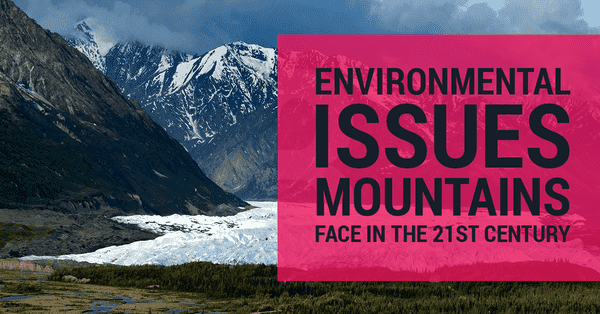
Mountaineering
BeginnerHiking
BeginnerRock Climbing
BeginnerIce Climbing
BeginnerBackcountry Skiing
BeginnerMountain Planet
12 years, Australia
ENVIRONMENTAL ISSUES FACED BY MOUNTAINS DURING THE 21st CENTURY

Will our grandchildren manage to see the Himalayas in their entire splendor? Take a moment to read and find out how climate change affects world’s mountains by modifying the mountain terrain beyond the recognition…
Climate change dramatically influences mountains environment. Mountains have warmed up considerably for the past 100 years and the warming will keep growing.
According to the IPCC Fifth Assessment Report by the period of 2085 - 2100 the planet will warm between 1.5 °C and 4.5 °C in a good case scenario…
Interesting fact: temperature growth is expected to be stronger over the land than over the ocean, rather at high altitudes than near the ground. This can accelerate glaciers and mountain snowpacks melting and reduce long term water supplies.
The humanity needs to combine efforts and answer the call otherwise in some hundred of years a typical mountain range may present rather an apocalyptic picture: barren eroded slopes, exposed to sweeping winds and merciless sunlight. Mountains will lose the vegetation cover, wildlife will come to extinction, glaciers and snowpacks may retreat much higher to the peaks or disappear completely.
If mountains change, our life will be affected too and here’s why:
The world’s mountains are providing vital eco services for the entire planet. Mountains are not only important tourist destinations; they are also key centers for raw materials, biological diversity and home to about 800 mln. people. Mankind heavily depends on mountains since half of the planet freshwater comes from mountain regions.
Unfortunately, within the past few decades mountains have been suffering from the global warming effect, primarily caused by air pollution.
Today, world’s mountains are facing a number of climatically driven challenges which seem to be growing every year. Here are a few of the dramatic changes that mountains are being subjected to in these days:
Soil loss
Steep slopes of the mountains are particularly sensitive to production soil loss through the erosion in case of vegetation removal. The productive soil then fills the streams, reducing fish habitat, it also pollutes lakes and reservoirs. Soil loss has turned some picturesque mountain slopes into dunes which threaten the area with massive landslides, damming the rivers, cutting communications and burying nearby entire villages.
Water management
Mountains are crucial water suppliers for the surrounding regions. The glaciers provide great water storage and regular water runoff. With global warming, glaciers and snowpacks are disappearing too fast which eventually results in water shortage in the lowland areas.
Serious measures must be taken to maintain mountains water management function, first – to restore vegetation cover in watersheds otherwise erosion, landslide or avalanches may damage the mountain regions.
Mountain streams and lakes are very sensitive to pollution since they are naturally poor in nutrients.
Vegetation cover
The damage of vegetation cover in the mountains may cause serious problems such as flooding, soil erosion and habitat loss of the risking species. The growing season in the mountain areas is short and it takes time to restore the natural vegetation cover of the mountains.
The forests is an essential factor in sustaining environmental health of the mountains and helping to prevent natural hazards such as landslides and maintaining water quality.
Health concerns
Сlimate change may lead to the distribution of the so called vector-borne disease. Due to temperature rise, some mountains and upland areas, today, may experience more favorable temperature and moisture conditions for spreading such diseases as malaria.
Tourism
Over the past two decades tourism and recreation have become one of the fastest-growing industries. Clearing slopes for skiing tracks and developing tourist infrastructure in mountain areas can seriously modify the environment. The overcrowding and seasonal populations of tourists can exhaust the water supplies and waste disposal facilities.
The climatically driven changes put in danger plants and animals rare species by reducing the natural habitat in the mountain regions. As Alpine environments get less snow every year, animals which enjoy cold alpine weather have to move higher. But it only lessens their habitat since mountains are usually cone shaped. Eventually, animals such as snow-leopards, will have no habitat to live in.
Climate degradation also threatens people who live in the mountain regions increasing hunger and poverty in the mountain communities. Thousands of men and women have to migrate to lowlands; unique cultures and languages are facing the risk of extinction.
It was believed that the Himalayas are capable of blocking air pollution from reaching the glaciated peaks. Unfortunately, the latest research based on satellite images shows that air pollution – visible from satellite as a brown cloud – is spreading across the highest mountains range and penetrates central Tibet.
The situation is even more catastrophic in India and Nepal where, during dry winters, huge territories seem to be plagued with severe air pollution. Over the last century the world’s mountain regions have warmed considerably and the average temperature is expected to keep growing. The glaciers in the Himalayas are melting away like never before.
It is a common problem from the Andes to the Alps. The ice at high altitudes is simply disappearing by creating impassable sections for climbers. As the average temperature has grown by more than 1,5 degrees since the late 1800s, the ice avalanches and rockslides became even more frequent threatening to increase mortality rate amongst climbers.
Climatically driven changes may also seriously impact seasonal patterns of tourism. For example, in some mountain areas, skiing and winter sports have become impossible to be practiced due to the global warming effect.
The global climate change makes mountains less accessible and more risky destinations. It now seems more important than ever to provide to the global Alpine community secure information about routes, conditions, equipment and service providers and build effective and efficient communication within the global Alpine Community.
For this reason we designed mountainplanet.com – a global geo-informational social network for the Alpine Community. We aim to connect the Alpine Community endeavours into global outcomes and help to preserve the mountains for future generations by engendering, empowering and encouraging people’s attitude (from the environmental point of view) to this natural phenomenon.





